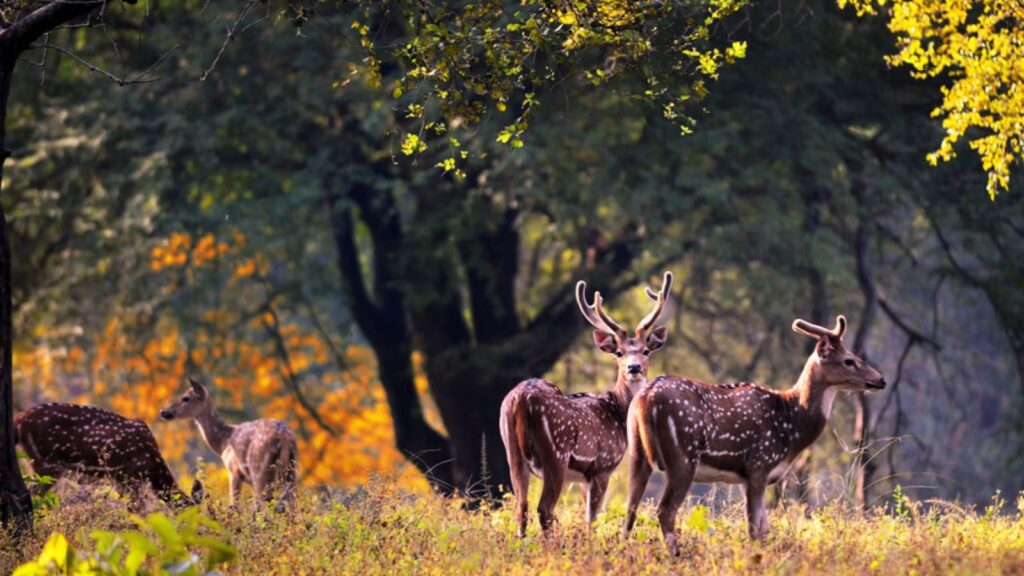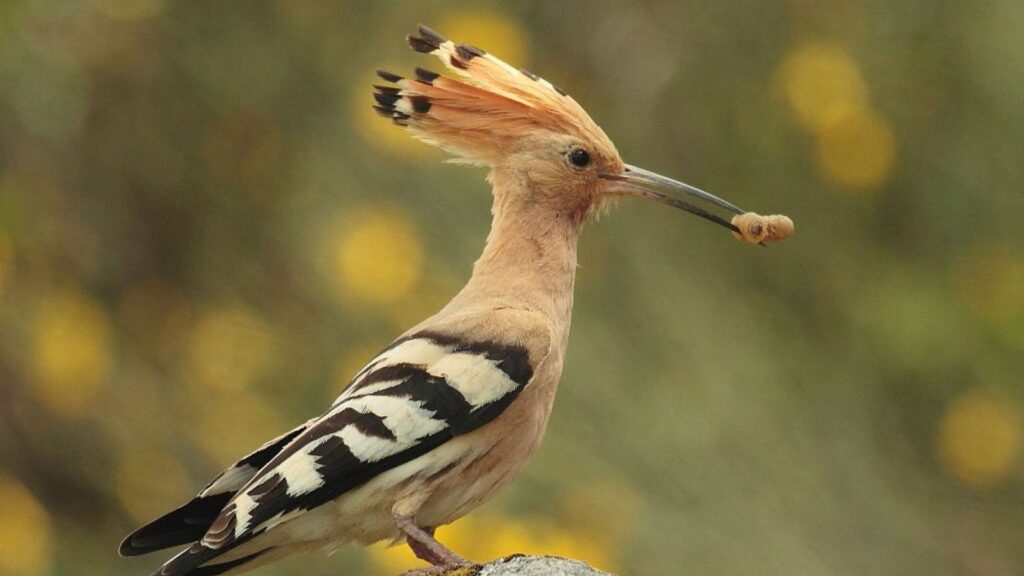
Pench Tiger Reserve, located in the southern reaches of the Satpura Ranges, straddles the border between the states of Madhya Pradesh and Maharashtra in India. Here is some detailed information about Pench Tiger Reserve:
1. Wildlife Diversity:
Pench Tiger Reserve is renowned for its rich biodiversity. Apart from being home to the Bengal tiger, it hosts a variety of wildlife, including leopards, wild dogs, Indian bison (gaur), sloth bears, several species of deer (like spotted deer and sambar), and numerous bird species. The reserve’s diverse habitats, including teak forests, grasslands, and water bodies, provide an ideal environment for this vibrant wildlife.
2. Flora and Fauna:
The flora of Pench Tiger Reserve is characterized by teak, mahua, saag, and many other tree species. It is a significant region for conservation of the critically endangered Indian wild dog, also known as dhole.
3. Pench River:
The reserve is named after the Pench River, which meanders through the park. The river not only provides a water source for the park’s wildlife but also adds to the scenic beauty of the reserve.
4. Jungle Safaris:
Pench offers thrilling jungle safaris that allow visitors to explore the park’s wilderness. Both morning and evening safaris are conducted in open-top jeeps, offering a chance to observe the wildlife in their natural habitat. The safaris are guided by knowledgeable naturalists who enhance the visitor experience by sharing insights about the park’s flora and fauna.
5. Birdwatching:
Pench Tiger Reserve is a paradise for birdwatchers. The park is home to over 285 bird species, including several migratory birds. The birdwatching experience here is particularly rewarding due to the diverse avian population.
6. Conservation Efforts:
Pench Tiger Reserve is actively involved in conservation initiatives, focusing on the protection of tigers and their habitat. Conservation efforts also extend to other wildlife species, ensuring the overall ecological balance of the region.
7. Best Time to Visit:
The best time to visit Pench Tiger Reserve is during the dry season, from October to June. The months of March to May are particularly excellent for wildlife sightings as water sources within the park start to dry up, making it easier to spot animals near remaining water bodies.
8. Accommodation:
There are various resorts and lodges around Pench Tiger Reserve that offer comfortable accommodation options. Many of these lodgings are designed to provide visitors with a close-to-nature experience.
9. Visitor Guidelines:
- Visitors are expected to follow the instructions of the guides and naturalists during safaris.
- Maintaining silence during the safari increases the chances of wildlife sightings.
- Littering is strictly prohibited, and tourists are encouraged to follow eco-friendly practices.

Pench Tiger Reserve offers an incredible opportunity for wildlife enthusiasts to witness the magnificence of tigers and other wildlife in their natural habitat, making it a must-visit destination for nature lovers.
Pench Tiger Tour: Unveiling the Wild Majesty
Embark on an unforgettable journey into the heart of the wild with our exclusive Pench Tiger Tour. Discover the enigmatic world of Pench Tiger Reserve, where the majestic Bengal tiger roams freely amidst pristine forests, grasslands, and meandering rivers. Here’s what you can expect from this immersive wildlife experience:
Tour Highlights:

1. Jungle Safaris:
Explore the wilderness of Pench on thrilling jungle safaris. Led by experienced naturalists and guides, venture into the heart of the reserve aboard open-top jeeps. Traverse diverse landscapes, from dense forests to open grasslands, and witness the incredible biodiversity that Pench is famous for. Be prepared for awe-inspiring encounters with the regal Bengal tiger, leopards, wild dogs, and a myriad of other wildlife species.
2. Birdwatching Extravaganza:
Pench is a paradise for bird enthusiasts. Discover the joy of birdwatching as you spot both resident and migratory avian species. With over 285 bird species gracing the skies of Pench, including the vibrant Indian Pitta and the majestic Crested Serpent Eagle, every moment promises a delightful ornithological experience.
3. Scenic Beauty and Photography:
Capture the beauty of Pench’s landscapes through your lens. From the serene Pench River winding its way through the forest to the golden hues of the savannah during sunrise and sunset, the park offers incredible opportunities for photography. Whether you are an amateur or a seasoned photographer, every frame tells a story of the wild.
4. Wildlife Interpretation and Guided Walks:
Delve deeper into the natural history of Pench with expert-led wildlife interpretation sessions. Participate in guided nature walks, where you can learn about the flora, fauna, and ecological significance of the region. Gain insights into animal behaviors, habitat dynamics, and the conservation efforts underway to protect Pench’s wildlife.
5. Comfortable Accommodation:
Relax and rejuvenate in carefully selected resorts and lodges nestled in the lap of nature. Experience the perfect blend of comfort and wilderness living. Enjoy cozy evenings around the campfire, sharing stories of the day’s adventures with fellow travelers.
6. Ethical and Responsible Tourism:
Our Pench Tiger Tour emphasizes responsible tourism practices. We adhere to strict guidelines to ensure minimal ecological impact, respecting the natural habitat and the animals that call Pench home. By choosing this tour, you actively contribute to the conservation of this incredible ecosystem.
Tour Inclusions:
- Accommodation in eco-friendly resorts/lodges
- All meals during the tour
- Guided jungle safaris with experienced naturalists
- Birdwatching sessions
- Wildlife interpretation talks
- Guided nature walks
- Park entry fees and necessary permits
- Round-the-clock assistance and support
Join Us in the Wild:
Embark on this extraordinary Pench Tiger Tour and immerse yourself in the wild wonders of nature. Witness the raw beauty of the jungle, hear the calls of the wild, and experience the thrill of encountering the magnificent tigers of Pench. Book your adventure today and let the untamed spirit of the wild captivate your senses. Your journey into the heart of Pench begins here!
Eco-Friendly Accommodation: Where Comfort Meets Conservation:

Choosing accommodation in eco-friendly resorts and lodges not only ensures a comfortable stay but also contributes significantly to environmental conservation. These establishments are designed to minimize their impact on the environment while offering guests a unique and sustainable experience. Here’s what you can expect from accommodation in eco-friendly resorts and lodges:
1. Sustainable Architecture:
Eco-friendly resorts and lodges are often built using sustainable materials and techniques. The architecture blends harmoniously with the natural surroundings, incorporating elements like thatched roofs, local stone, and reclaimed wood. The designs prioritize energy efficiency and minimize the use of resources.
2. Low-Impact Amenities:
Guest rooms are equipped with energy-efficient lighting, low-flow water fixtures, and eco-friendly toiletries. These resorts often use renewable energy sources such as solar power and employ waste management systems to reduce their carbon footprint. Rainwater harvesting and water recycling practices are also common features.
3. Natural Landscaping:
The landscaping around eco-friendly accommodations emphasizes native plants that require minimal water. These resorts often maintain gardens that are not only aesthetically pleasing but also provide habitats for local wildlife. Guests can enjoy the beauty of the natural environment without disrupting the local ecosystem.
4. Conservation Initiatives:
Eco-friendly resorts actively engage in conservation initiatives. This can include tree planting programs, wildlife habitat restoration projects, and active participation in local community development. Guests are often encouraged to participate in these activities, fostering a sense of environmental responsibility.
5. Local and Organic Cuisine:
Sustainable resorts prioritize sourcing ingredients locally, supporting nearby farmers and promoting organic produce. Guests can savor delicious meals made from fresh, seasonal, and locally sourced ingredients. This not only reduces the carbon footprint but also offers an authentic culinary experience.
6. Education and Awareness:
Eco-friendly resorts often conduct workshops and awareness programs to educate guests about the local environment, wildlife conservation, and sustainable living practices. These initiatives promote environmental consciousness among travelers.
7. Tranquil Ambiance:
With their focus on natural harmony, eco-friendly resorts provide a serene and tranquil ambiance. Guests can unwind in the midst of nature, enjoying the sounds of birds and the rustling of leaves, creating a peaceful retreat away from the noise and stress of urban life.
8. Responsible Tourism:
Staying in eco-friendly resorts allows travelers to be responsible tourists. By choosing such accommodations, guests actively contribute to the preservation of natural habitats and local communities, ensuring that the destination remains pristine for future generations.
Choosing accommodation in eco-friendly resorts and lodges is not just a choice for comfort; it’s a commitment to the planet. It’s an opportunity to enjoy the beauty of nature responsibly, leaving a positive impact on the environment and supporting the sustainable development of the local community.
Guided Jungle Safaris with Experienced Naturalists: A Journey into the Wild

Embarking on a jungle safari with experienced naturalists transforms a wildlife excursion into an enriching and educational adventure. Here’s what you can expect from guided jungle safaris with knowledgeable naturalists:
1. Expert Insight:
Experienced naturalists are well-versed in the behavior, habitat, and ecology of the wildlife you encounter. Their expertise enriches your safari experience by providing in-depth information about the animals, birds, plants, and even insects, enhancing your understanding of the ecosystem.
2. Animal Tracking Skills:
Naturalists possess exceptional tracking skills, enabling them to read signs left by animals. They can interpret paw prints, markings, and sounds, increasing the likelihood of spotting elusive creatures. Their ability to anticipate animal movements enhances the thrill of wildlife encounters.
3. Safety and Interpretation:
Naturalists prioritize your safety during the safari. They understand animal behavior and ensure a safe distance between the wildlife and the safari vehicle. Additionally, they interpret animal actions, ensuring you recognize signs of agitation or relaxation, enhancing your overall wildlife observation experience.
4. Birdwatching Expertise:
For birdwatchers, naturalists identify various bird species based on their calls, flight patterns, and nesting behaviors. They carry field guides and binoculars, making it easier for you to spot and identify different avian species. Their knowledge adds depth to your birdwatching adventure.
5. Storytelling and Conservation Insights:
Naturalists are often excellent storytellers, sharing fascinating anecdotes about the wildlife you encounter. They weave stories about animal behaviors, local folklore, and conservation efforts, providing a holistic understanding of the region’s natural heritage.
6. Environmental Awareness:
Naturalists raise awareness about environmental conservation. They share insights into the challenges faced by the local ecosystem, shedding light on the importance of wildlife protection and habitat preservation. Guests leave with a heightened sense of responsibility towards nature.
7. Customized Experiences:
Experienced naturalists customize safaris based on guest interests. Whether you’re passionate about big cats, avian species, or flora, they tailor the safari route to maximize your interests, ensuring a personalized and fulfilling wildlife experience.
8. Educational Opportunities:
For families and students, naturalists provide educational opportunities. They engage younger participants with interactive sessions, teaching them about wildlife, ecosystems, and the importance of biodiversity conservation, making safaris not only thrilling but also educational.
9. Lifelong Memories:
Guided jungle safaris with experienced naturalists create lasting memories. Their knowledge and passion enhance every wildlife sighting, transforming your journey into an unforgettable adventure that you’ll cherish for a lifetime.
Embarking on a guided jungle safari with experienced naturalists not only amplifies the excitement of encountering wildlife but also fosters a deep appreciation for nature’s wonders. It’s an opportunity to learn, connect, and be inspired by the marvels of the wild.
Birdwatching sessions

Birdwatching: A Journey into the Avian World
Birdwatching, also known as birding, is a beloved hobby and a rewarding outdoor activity that involves observing and identifying birds in their natural habitats. It’s a fascinating way to connect with nature, appreciate biodiversity, and enjoy the serene beauty of various bird species. Here’s what you need to know about birdwatching:
Getting Started:
- Equipment: A good pair of binoculars is essential for birdwatching. Opt for binoculars with a comfortable grip and clear optics. A field guidebook specific to your region helps identify different bird species.
- Clothing: Wear muted, comfortable clothing and suitable footwear. Neutral colors help you blend into the environment, reducing the chances of disturbing the birds.
- Patience and Silence: Birdwatching requires patience. Birds are easily startled by noise, so remain silent and still to observe their natural behaviors.
Hoppoe Birds

Physical Characteristics:
- Appearance: Hoopoes are medium-sized birds, approximately 25–32 cm (9.8–12.6 inches) in length. They are recognized by their unique appearance, featuring a long, slender, curved bill and a conspicuous crown of feathers on their head, resembling a fan or a hoop, hence the name “Hoopoe.”
- Coloration: Their plumage is a combination of orange, pink, brown, black, and white, with striking black and white stripes on their wings and tail. The crest on their head is often raised and lowered as a part of their display.
- Habitat and Distribution:
- Hoopoes are found in a wide range of habitats, including open woodlands, savannas, grasslands, and urban areas. They are native to Europe, Asia, and parts of North Africa. They are migratory birds, with some populations moving to warmer regions during winter.
- Behavior and Diet:
- Diet: Hoopoes primarily feed on insects, especially beetles, caterpillars, and ants. They use their long, slender bill to probe the ground for prey, and their diet is particularly rich in insects considered pests to agriculture.
- Nesting: Hoopoes are cavity nesters and often choose natural holes in trees or abandoned woodpecker nests. They line the nest with grass, feathers, and other soft materials.
- Vocalization: Hoopoes are known for their distinctive “oop-oop-oop” calls, which are often heard before they are seen. They also produce soft hissing sounds.
PENCH TIGER RESERVE
Location and Overview: Pench Tiger Reserve is located in the southern region of Madhya Pradesh, India, near the border of Maharashtra. It is named after the Pench River that flows through the reserve. Established in 1992, the reserve encompasses diverse landscapes, including deciduous forests, grasslands, and water bodies, creating an ideal habitat for a variety of wildlife, including the iconic Bengal tiger.
Key Features:
1. Rich Biodiversity: Pench Tiger Reserve is renowned for its rich biodiversity, housing not only Bengal tigers but also leopards, Indian wild dogs, Indian bison (gaur), spotted deer, sambar deer, and various bird species.
2. Flora and Fauna: The reserve boasts a wide array of flora, including teak, mahua, and several medicinal plants. Its diverse fauna includes over 285 species of resident and migratory birds, making it a paradise for birdwatchers.
3. Tigers of Pench: The reserve is one of the best places to spot Bengal tigers in their natural habitat. The tigers of Pench are not only majestic but also crucial for the ecological balance of the region.
4. River and Water Bodies: The Pench River, after which the reserve is named, serves as a lifeline for the flora and fauna. Several water bodies within the reserve provide essential drinking water for the wildlife and create picturesque landscapes.
5. Safari Experience: Pench offers both jeep safaris and elephant safaris, allowing visitors to explore the wilderness and observe the wildlife up close. Experienced guides accompany these safaris, enhancing the experience with their knowledge.
6. Conservation Efforts: The reserve actively participates in conservation initiatives, focusing on tiger protection, anti-poaching efforts, and community engagement. These efforts aim to preserve the natural habitat and ensure the survival of endangered species.
7. Buffer Zones: Pench Tiger Reserve has established buffer zones around the core area to create a sustainable balance between conservation and human activities. These buffer zones promote eco-friendly practices and provide livelihood opportunities to local communities.
8. Tourism and Education: Besides offering thrilling wildlife experiences, the reserve also focuses on environmental education. Visitors have the opportunity to learn about the local flora, fauna, and conservation efforts through interpretive centers and guided tours.
Conclusion:
Pench Tiger Reserve stands as a testament to India’s commitment to wildlife conservation. It provides a haven for both the magnificent Bengal tiger and a myriad of other species. Visitors not only witness the splendor of nature but also become part of the ongoing efforts to protect and preserve one of India’s most treasured ecosystems. A visit to Pench is not just a safari; it’s an immersive journey into the heart of the wild.



